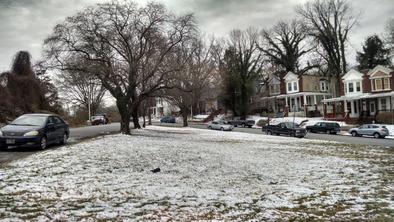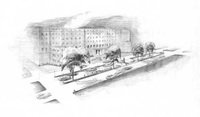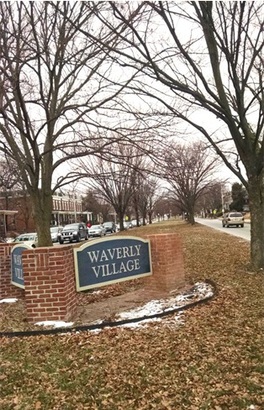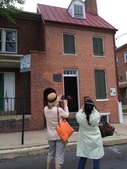Olmsted Parkways: A Green Ribbon Connecting the City
Baltimore has been shaped immensely by the work of
landscape architect Frederick Law Olmsted and his sons, who left their
signatures across Baltimore’s landscape, particularly in the city’s parks and suburban
style neighborhoods. A part of that landscape legacy is being considered for
designation as a Baltimore City Landmark by the City Council (CCB 14-0453). The designation will include the Gwynns Falls
Parkway, 33rd Street, and a portion of the Alameda, which are collectively
being named the “Olmsted Parkways” and which connect the majority of the larger
parks in the City’s park system.

Frederick Law Olmsted, Jr., and his firm Olmsted Brothers
Landscape Architects, produced the 1904 "Report Upon the Development of Public
Grounds for Greater Baltimore", which laid out a plan for a comprehensive park
system for the Baltimore region, comparable to that of Boston. This plan was
largely completed, and is why we have the large parks system that exists today.

One important facet of that parks system is the parkways
that create an east/west connection between Gwynns Falls/Leakin Park to the
west, Druid Hill Park, Wyman Park, Lake Montebello and Clifton Park to the
east. The intention of the Parks plan was to create an “Emerald Necklace”, with
the parks serving as the jewels, and the parkways serving as linear connecting
parks.
These parkways were not simply roadways, but served as
parks themselves, with wide medians planted with trees and shrubbery. They
ensured that citizens had access to green space – which was a rare commodity in
many cities 100 years ago. These linear greenways were also seen as an
excellent way to spur residential development along the parkways, which helped
the housing and population boom in the early 20th century. The parkways also
were originally intended to be a “complete streets” model, serving pedestrians,
bicyclists, cars, and carriages alike. This view of green space as a valuable
commodity for attracting residents, spurring growth, and fostering multi-modal
transportation is one that is appreciated again today.
|
 |
The designation of the “Olmsted Parkways” honors their
historic significance, will ensure that these boulevards will continue to be
enjoyed by future generations, and provides an opportunity for the City to
celebrate this 100-year legacy.
The Commission for Historical and Architectural
Preservation (CHAP) and the Planning Department have worked collaboratively with
various city agencies, such as DOT, DPW, and Rec & Parks, regarding this
designation to ensure that all of the agencies that are responsible for these
parkways are comfortable with the design review goals and procedures that come
with Landmark designation. CHAP already reviews and comments on plans for
roadways and historic properties owned by the City, and this designation will
simply codify the significance of these leafy corridors connecting our
neighborhoods and parks, ensuring the City’s stewardship far into the
future.

Celebrating Edgar Allan Poe:
An Update from Poe Baltimore
We
think Edgar Allan Poe would be humbled and delighted to see his former home at
203 N. Amity Street has been busy since it was reopened by Poe Baltimore, Inc.
Ardent visitors from around the world have made pilgrimages to Baltimore’s Edgar
Allan Poe House & Museum, and after tap, tap, tapping at his front door,
have experienced many “POE-tic” treats. In 2014, the house opened
briefly for his January 19 birthday, and then again every weekend between 11am
and 4pm from Memorial Day to the end of December. During that time, more than
5,900 enthusiastic visitors of all ages crossed the weathered Amity Street
threshold to explore Poe’s life, warmly welcomed by a dedicated group of
volunteer docents.
 Many other special Poe events dazzled visitors
throughout the city, including author of best-selling thrillers, Steve
Berry’s grand opening presentation, and later during Artscape,
the Book Festival, and FreeFall Baltimore, when four FreeFall “Nomadic
POE-try
Events” were staged at various Poe-sites. These notable performances
included Tony Tsendeas’s mesmerizing
performance of “The Black Cat” at Poe’s Westminster grave, and beatboxer
Shodekeh’s compelling event at the Moses Ezekiel Statue.
During the fall,
visitors celebrated the Day of the Dead, took a Poe-themed Ghost Tour in Fells
Point, enjoyed Baltimore illustrator David Plunkert’s book signing at the
B&O Railroad Museum, and swinging Poe enthusiasts were ready to dance
during Poe Baltimore’s 2nd“Black Cat Ball” fundraiser at the Mobtown Ballroom.
A new partnership with the Maryland Institute of Art and the Excel Academy offers
an exciting examination of ways to interpret Poe. Then more recently, Mike
Rowe spent an afternoon filming at the Poe House for his upcoming 9pm Wednesday
night CNN series, “SomeBody’s Gotta Do It”.
We’ll keep you posted about this
broadcast and many more exciting Poe events that will be happening over the next year.
|
Capital Improvement Program Update:
On
Thursday, February 26 at 9am, Planning Department staff will brief the
Planning Commission on its recommendations for the FY16-21 Capital Improvement
Program (CIP).
The Planning Commission will then vote on those recommendations on March 12 at
1:30pm. Both meetings will take place at 417 East Fayette
Street, on the 8th Floor.
Following
approval by the Planning Commission, the CIP must be
approved by the Board of Finance and Board of Estimates. The first
year of the six year program is the upcoming budget year and becomes the basis for the
capital component of the Ordinance of Estimates, adopted by City Council, which
takes effect on July 1, the beginning of the City's fiscal year.
For additional information about the CIP, please e-mail us at plan@baltimorecity.gov or visit our website.
Call for Historic Preservation Award Nominations
What historic places have been restored in your neighborhood? Are you a home-owner celebrating the end of a jaw-dropping rehabilitation project? Or the architect behind an inspired example of adaptive reuse? Baltimore Heritage is looking for Baltimore’s best preservation projects for their 2015 Historic Preservation Awards. Nominations must be submitted by Friday, March 6, 2015 for consideration.
Awards will be presented at the Baltimore Heritage annual awards celebration in June. |